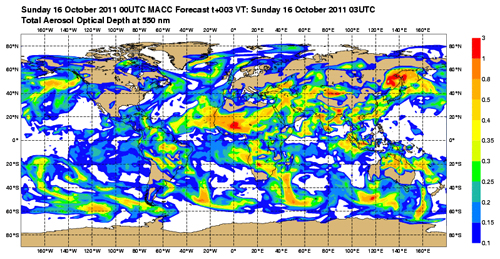Aerosol Forecast
The MACC (Monitoring Atmospheric Composition & Climate) project computes forecasts of "anthropogenic aerosols", defined as organic matter, black carbon and sulfate aerosols that are emitted from fires and other, mostly anthropogenic, sources. An example of simulated aerosol optical depth (AOD), including emissions derived from the latest observed fire distribution and assimilation of space-borne AOD observations, including emissions derived from the latest observed fire distribution and assimilation of space-borne AOD observations, is shown in Figure 5.34. The fire distribution maps used as input in these simulations are obtained from the D-fire subproject, as mentioned in the Hot Spots Gallery subchapter.

The optical depth of the simulated resulting smoke aerosols (organic matter, black carbon, and sulphate) from the fires that occurred in Greece in August 2007 are presented in figure 5.35. The left panel shows the fire intensity observed by the SEVIRI instrument in terms of fire radiative power (FRP per unit area at 25 km resolution, reddish color bar) and the optical depth of the simulated resulting smoke aerosols (AOD, bluish color bar), for the 26 and 27 August. Images on the right show concurrent MODIS observations; the simulations and observations of the Greek fire plumes display very similar shapes.